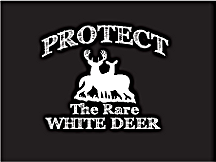
Hazard in the Hay Field
According to a 2010-2014 study on deer predation in Wisconsin done at two locations–one in east central Wisconsin and one in northern Wisconsin, the main predators of fawns are bears, bobcats, and coyotes. But those of us in southern Wisconsin–at least in Sauk County, and at least in the Leland area–know that the main “predator” of fawns by far is the hay mower.
One farmer in the Leland area says he gets an average of five fawns a year, with 13 being the record one year when there was an abnormally early spring and tall alfalfa crop. It’s a sad picture, but last spring it was even sadder when one farmer hit two white fawns with his mower. How many other white fawns were killed by hay mowers and not reported?
It’s an unfortunate truth that deer love to hide their fawns in the edges of alfalfa fields where they are nearly impossible to see (even the white ones!) Even when in obvious danger, a fawn’s instinct is to hunker down and freeze–behavior that at other times would make perfect sense. But not when a hay mower is bearing down on them.
Nobody is happy with mower deaths–whether they are fawns or wild turkeys, game birds, small mammals, or even domestic cats and dogs. But most people throw up their arms in resignation and say, “But what can you do?”
Although nothing is 100%, there are methods to minimize the grisly deaths that often come with the hay harvest. Here is a list that will help ensure that fawns of any color have a better chance of beating the mower.
1) Delay mowing if possible–even if only for a few days. It may give fawns enough time to be more mobile and able to leave the area.
2) Have someone walk the field in a zigzag pattern prior to mowing (good work for kids!). Since fawns freeze, it doesn’t guarantee finding them, but it helps. If you find one, stake the spot, since the fawn probably will come back–even if you carry it out of the field! Flushing the doe will also give a clue where her fawns are.
3) Better yet, take your dog and walk the field a day or several days in advance. The fawns are scentless at this age, and your dog probably won’t find them, but having a “predator” like this in the field prior to mowing may convince mom to move her fawn(s).
4) Mow from the inside of the field to the outside so animals aren’t trapped by a closing circle. Go either in an enlarging path or back and forth from the center of the field. Mowing toward an area of cover (woods or unharvested fields) can also give animals a route to escape.
5) Set your mower as high as possible–even 5-6 inches can be enough to go over most birds and animals.
6) Reduce tractor speed in areas with possible wildlife. Granted, new haybines are designed to go fast, and farmers are in a hurry to beat the weather, but slowing even a little can give wildlife more time to get out of the way.
7) Mow only during daylight. Animals are less apt to be bedded down and it’s easier for the driver to see what he is mowing. Seeing a doe standing nearby, refusing to move, or flushing in front of the mower is a good sign there is a fawn close by.
8) Leave the outer edges of the hay field for last–that’s where most of the fawns will be. If it’s not possible to delay harvesting the whole field, not mowing the edge for a week or two, especially towards the wooded side of a field, will help.
9) Use a wildlife flushing bar–a horizontal bar with hanging chains attached to the front of your tractor to nudge or scare wildlife out of the way. While this method works best in shorter and less dense hay–and may not be totally useful for fawns that freeze in place–it’s still worth a try and would definitely help other wildlife.
So, yes, there are things you can do that won’t take a lot of extra effort, but can help protect wildlife–especially our white fawns. Pass the word.

